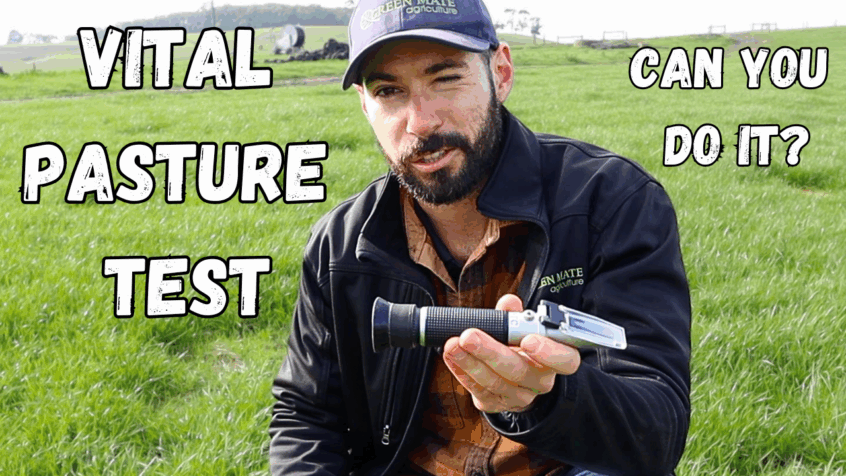Boost Pasture Health with a Garlic Press? How BRIX Testing Can Change the Way You Farm

What if you could measure the health of your pasture—and the effectiveness of your management—using tools you probably already have at home?
In a recent Farm Learning video, we joined Ben from GreenMate Agriculture to explore one of the most underutilised and misunderstood tools in regenerative and conventional agriculture: the BRIX test. With nothing more than a garlic press, a cheap refractometer, and some good timing, you can gather meaningful data about your soil, plant health, and even pest resistance.
Here’s what you need to know.
What Is a BRIX Test and Why Should You Care?
BRIX testing measures the sugar content in plant sap. While it might sound simple, the implications are powerful. Sugar levels in plants tell us how efficiently they’re photosynthesising, how well they’re accessing nutrients, and how resilient they are to disease and pests.
Higher BRIX = Healthier Plant. It’s that simple.
And it’s not just about feed quality. High BRIX readings correlate with:
- Better plant immunity
- Greater drought resistance
- Increased pest resistance
- Improved nutritional value for livestock
Ben explains that stressed plants—due to drought, nutrient deficiency, or mismanagement—often show low BRIX levels. But with some clever tweaks, you can boost those readings and your farm’s productivity. One of the best ways to optimise plant photosynthesis without adding chemical fertiliser is Crop Bio-Life. Check out the link for more info on this!
Tools You’ll Need (Hint: You Already Have Them)
Forget expensive gear. Here’s the bare minimum:
- A garlic press (yes, from the supermarket)
- A BRIX refractometer (available online for under $50)
- A small selection of fresh pasture from the paddock
You simply press a few representative grass samples, place a drop of the juice on the refractometer, and look through the eyepiece to read the sugar level. Simple, quick, and totally DIY.
What BRIX Readings In Ryegrass Pasture Mean
- 0–2° BRIX: Likely stressed; low nutrition and immunity
- 3–4.5° BRIX: Moderate health
- 5–6° BRIX and above: Healthy, nutrient-dense, and resilient
Ben suggests aiming for 5–6° BRIX or more in southern Victoria pasture during growing seasons. But remember—seasonal variation is natural. The real value lies in tracking your own trend data. Multi species crops can be much higher still!
When and How Often Should You Test?
You can test anytime, but for meaningful insights:
- Test once per season, especially in key transition periods (e.g., autumn break, spring flush)
- Track annually to compare growing conditions and the impact of grazing or fertiliser regimes
- Zone test within paddocks to spot variations in stress or performance
The real power of BRIX is that it puts quantitative data in the hands of the grower, helping validate what your eyes are already telling you.
What If Your BRIX Is Low?
Low readings don’t always mean failure—they tell you where to dig deeper:
- Is your pasture under heat or water stress?
- Are you overusing synthetic fertilisers, damaging plant metabolism and soil biology?
- Is your grazing pressure too high or your recovery period too short?
Ben suggests options like biostimulants (e.g., Crop BioLife) to kickstart plant metabolism. Importantly, consider the whole system—grazing management, soil structure, organic inputs, and water availability all play a role in plant sugar accumulation.
BRIX Testing as a Holistic Management Tool
The beauty of BRIX testing isn’t in the number—it’s in what it reveals about your management practices. It provides real-time feedback on:
- Pasture health
- Soil microbial activity
- Grazing timing
- Recovery success
Rather than relying solely on gut feel or trial and error, BRIX gives you repeatable, visual evidence to support your decisions.
Final Thoughts: Start Small, Learn Big
Whether you’re managing a backyard block or 1,000 hectares, BRIX testing is one of the simplest tools to level up your pasture management. As Ben says, “It’s a free test, once you have the equipment.” And with practice, it can become one of the most valuable habits in your regenerative toolkit.
👉 Want to learn more or get help with testing?
Reach out to Ben at GreenMate Agriculture for advice and gear.
📺 Watch the full video on the Farm Learning Channel to see BRIX testing in action.
💬 Know a mate who’s battling pasture quality? Send them this blog or tag them under the video.
🔔 Subscribe to the Farm Learning YouTube channel for more weekly insights into better farming—cheaper, smarter, and more sustainable.